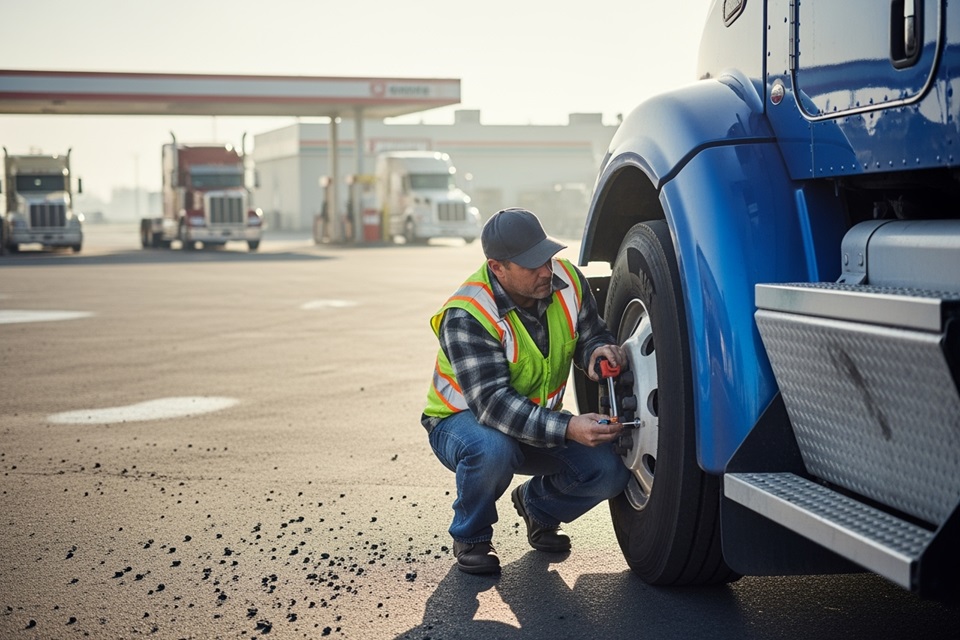Table of Contents
Driving a commercial vehicle carries a significant responsibility. We must ensure the safety of ourselves, our cargo, and everyone else on the road. This journey of safety often begins and ends with thorough vehicle inspections.
The Department of Transportation (DOT) and the Federal Motor Carrier Safety Administration (FMCSA) set clear guidelines. These rules are not just bureaucratic problems. They are vital practices designed to prevent accidents and keep our roadways safe.
This comprehensive guide will explain the essential world of DOT pre-trip and post-trip inspections. We will explore the specific requirements, who is responsible, and the key components to check. We will also highlight the differences between these inspections and the serious consequences of non-compliance. Our goal is to help you stay compliant and safe.

Before a commercial motor vehicle (CMV) even turns its engine, a critical step must occur: the pre-trip inspection. This is not merely a suggestion; it’s a fundamental requirement under FMCSA regulations, specifically detailed in 49 CFR 396.13. The driver is legally obligated to be satisfied that the vehicle is in “good working order” before operating it. This proactive measure is paramount for vehicle safety and accident prevention, protecting not only the driver but also the public.
Key Question 1: What are the DOT requirements for pre-trip inspections? The DOT mandates that drivers conduct a thorough inspection of their commercial vehicle before each trip. This inspection aims to identify any defects or deficiencies that could affect the safe operation of the vehicle. If any issues are found, they must be addressed before the vehicle can be operated. The driver is ultimately responsible for ensuring the vehicle’s roadworthiness.
Key Question 3: Who is responsible for conducting pre-trip and post-trip inspections? The primary responsibility for conducting the pre-trip inspection rests squarely on the shoulders of the commercial driver. While maintenance personnel handle repairs, the driver must personally verify the vehicle’s safe operating condition before departure. This accountability cannot be delegated, and the driver may be held liable for operating an unsafe vehicle.

The Official DOT Pre-Trip Inspection Checklist
A comprehensive pre-trip inspection covers a wide array of vehicle components. While the exact list can be extensive, the FMCSA outlines a core set of items that must be checked. These typically include:
- Service Brakes: Ensuring they are operational and free from defects.
- Parking Brake: Verifying its functionality.
- Steering Mechanism: Checking for excessive play or damage.
- Tires and Wheels: Inspecting condition, pressure, and tread depth.
- Lights and Reflectors: Confirming all are working and clean.
- Coupling Devices: For combination vehicles, ensuring secure connections.
- Emergency Equipment: Such as fire extinguishers, warning triangles, and spare fuses.
- Windshield Wipers: Checking for proper operation and blade condition.
- Horn: Ensuring it’s functional.
For a more granular breakdown, many carriers provide detailed checklists. A comprehensive guide to conducting a pre-trip inspection can be found by reviewing resources like the Pre-Trip Inspection – A Suggested Checklist provided by industry experts.
Key Question 4: What are the key components to check during a pre-trip inspection? As listed above, the core components include brakes, steering, tires, wheels, lights, reflectors, coupling devices, emergency equipment, wipers, and horn. Additionally, drivers should check fluid levels (oil, coolant, power steering, windshield washer fluid), belts, hoses, and general vehicle condition for any leaks or structural damage.
Specific Component Checks: Brakes, Tires, and Steering
Paying close attention to specific measurements and indicators during the pre-trip inspection is crucial for safety and compliance.
- Brakes: Brake system violations are a leading cause of out-of-service orders. In fact, more than 1 out of every 4 vehicle out-of-service violations in the U.S. during the 2023 Commercial Vehicle Safety Alliance’s (CVSA’s) International Roadcheck were due to brake system violations. We must check brake pads for sufficient thickness, generally more than 1/4-inch thick. For air brakes, we verify air pressure (typically between 90-120 PSI), test low air warning devices, and perform an air loss test. Understanding how to determine air brake adjustment is also vital for maintaining proper stopping power.
- Tires: Tires are our vehicle’s direct connection to the road. We need at least 4/32-inch tread depth in every major groove on front wheels (steer tires) and 2/32-inch depth on other tires. Proper inflation is non-negotiable; “kick-checking” is insufficient. We must use a calibrated gauge to ensure correct tire pressure and inspect for cuts, bulges, or uneven wear.
- Steering: The steering system must be responsive and free from excessive play. Steering wheel play of more than 10 degrees (approximately 2 inches movement at the rim of a 20-inch steering wheel) can make it hard to steer and indicates a potential hazard. We should check for loose or bent components in the steering linkage.
Key Question 15: What are the specific requirements for inspecting brakes, tires, and lights during these inspections? For brakes, we check pad thickness, air pressure, warning systems, and for leaks. For tires, it’s tread depth (4/32″ steer, 2/32″ other), proper inflation, and overall condition. For lights, we ensure all lights (headlights, taillights, turn signals, brake lights, clearance lights) are clean, functional, and of the correct color.
How Long Should a Pre-Trip Inspection Take?
While the DOT doesn’t specify an exact time limit, industry best practices suggest that a thorough pre-trip inspection should take about 15 minutes. This timeframe allows an experienced driver to systematically check all critical components. For new drivers, it might take longer, perhaps 30 minutes or more, until they become familiar with the routine and location of all checkpoints. The emphasis should always be on thoroughness over speed. Rushing can lead to missed defects, compromising safety and compliance. A helpful resource for mastering this process is the 15-Minute DOT Pre-Trip Inspection Guide.
Key Question 6: How long should a pre-trip inspection take? Approximately 15 minutes for an experienced driver, though new drivers may take longer. Thoroughness is more important than speed.
The Post-Trip Inspection: Closing the Safety Loop
Once the day’s work is done and the vehicle is parked, the responsibility of inspection doesn’t end. This is where the post-trip inspection comes into play. While often less detailed than a pre-trip, its purpose is equally vital: to identify any defects or issues that may have developed during the journey. This helps prevent further damage, ensures the vehicle is ready for its next operation, and contributes to overall fleet maintenance and safety.
Key Question 2: What are the DOT requirements for post-trip inspections? Post-trip inspections are not explicitly mandated by DOT regulations in the same way pre-trip inspections are. However, the FMCSA does require drivers to report any defects or deficiencies found during the day that would affect vehicle safety or potentially result in a breakdown. This requirement is detailed in 49 CFR 396.11, which specifies that drivers of passenger-carrying and non-passenger CMVs must inspect vehicles and prepare and sign a written report at the completion of each day’s work on each vehicle operated if defects are found. This effectively necessitates a post-trip assessment.
The Driver Vehicle Inspection Report (DVIR)
The cornerstone of the post-trip process is the Driver Vehicle Inspection Report (DVIR). If defects are found during the post-trip assessment, the driver is required to document these findings. This report must detail any defects found and the corrective actions taken. The vehicle shall not be operated until the found defects are repaired. The motor carrier or its agent must certify that any listed defect(s) or deficiencies have been repaired or that immediate repair is unnecessary.
Drivers are required to document their pre-trip inspections in a vehicle inspection report if defects are found. This also applies to post-trip findings. The motor carrier must retain these original DVIRs, repair certifications, and driver review certifications for three months.
Key Question 10: What documentation is required for pre-trip and post-trip inspections? For pre-trip inspections, if no defects are found, no written report is required. However, if defects are found, they must be documented in a DVIR. For post-trip inspections, a DVIR is required if any defects are found during the day’s operation. This report must be signed by the driver, and if defects are noted, the carrier must certify repairs. Both the original DVIR and repair certifications must be retained for three months.

How Pre-Trip and Post-Trip Inspections Differ
While both are crucial for vehicle safety, pre-trip and post-trip inspections serve distinct purposes and have different focuses:
Feature Pre-Trip Inspection Post-Trip Inspection Purpose Proactive: Ensure vehicle is safe to operate before trip. Reactive: Identify issues developed during the trip. Timing Before starting operation each day. At the completion of each day’s work. Mandate: Explicitly required by DOT (49 CFR 396.13). Driver report of defects is required (49 CFR 396.11), but a formal “inspection” is often a best practice rather than explicitly mandated. Key Focus Roadworthiness, safety, operational readiness. Damage, wear, or malfunctions that occurred while driving. Documentation Required only if defects are found. Required if defects are found. Driver must sign. Carrier must certify repairs. Component Check Comprehensive, including cold components (fluids). Similar components, but often excludes hot components (e.g., fluid levels) and focuses on visible damage or operational issues. Key Question 9: How do pre-trip and post-trip inspections differ? Pre-trip inspections are mandatory before operation to ensure safety, while post-trip inspections are primarily for reporting defects found during the day’s work, although a formal inspection is a best practice. Pre-trips focus on readiness, post-trips on issues developed during the trip. Documentation is only required if defects are found for both.
Key Question 7: How long should a post-trip inspection take? While not explicitly timed by regulation, a post-trip assessment, especially if no defects are found, can be a quick walk-around. If defects are present, the time taken would be for thorough identification and documentation, which could vary.
Compliance and Consequences: Why Raleigh Honest DOT Inspections Matter
Neglecting pre-trip and post-trip inspection requirements carries significant risks, not just for safety but also for compliance and financial well-being. Failure to perform required inspections can lead to severe penalties, fines, and increased carrier liability.
During roadside inspections, federal and state officers can put a vehicle “out of service” until it is repaired if they deem it unsafe. As noted earlier, brake system violations alone contribute to a substantial portion of these out-of-service orders. These violations also negatively impact a motor carrier’s Compliance, Safety, Accountability (CSA) scores, which can lead to more frequent inspections and higher insurance premiums.
For any complex issues found during an inspection, getting Raleigh’s honest auto advice is crucial for safe and compliant repairs. Trustworthy service ensures your vehicle meets all regulatory standards, protecting your operations and reputation.
Key Question 8: What are the consequences of failing to perform required inspections? Consequences include penalties, fines, increased carrier liability, vehicles being placed “out of service,” and negative impacts on CSA scores, leading to more frequent inspections and higher insurance rates.
Who is Responsible for DOT Inspections?
The responsibility for effective inspections is shared:
- Drivers: Drivers are responsible for performing thorough inspections and accurately documenting their findings. This includes completing the DVIR if defects are found and reviewing the previous day’s report before operating the vehicle.
- Motor Carriers: Carriers must ensure that their drivers are trained in conducting pre- and post-trip inspections and that all inspections are documented properly. They are also responsible for ensuring that any reported defects are repaired before the vehicle is dispatched again, and for certifying these repairs. This comprehensive approach ensures that everyone involved understands their role in maintaining vehicle safety and regulatory compliance, as outlined in the FMCSA’s vehicle inspection guidelines.
Common Mistakes to Avoid During Inspections
Even experienced drivers can fall into common pitfalls that compromise the effectiveness of their inspections:
- Rushing the Inspection: Attempting to complete a pre-trip inspection in less than the recommended 15 minutes often leads to missed critical issues.
- “Kick-Checking” Tires: This method is ineffective for accurately assessing tire pressure or identifying subtle damage. A calibrated tire gauge is essential.
- Inconsistent Routine: Performing checks in a random order increases the likelihood of overlooking components. A systematic, consistent routine (e.g., starting at the cab, moving around the vehicle) is best.
- Forgetting In-Cab Checks: The interior of the cab, including gauges, mirrors, wipers, and safety equipment, is just as important as external components.
- Ignoring Minor Issues: What seems minor today could become a major safety hazard or out-of-service violation tomorrow. All defects, no matter how small, should be reported.
- Poor Documentation: Inaccurate or incomplete DVIRs can lead to compliance issues and make it difficult to track repairs.
Avoiding these common mistakes ensures that inspections are not just a regulatory formality but a genuine effort to maintain vehicle safety.
Modernizing Inspections and Understanding Different Types
The landscape of commercial vehicle operations is constantly evolving, and so too are the tools and methods for ensuring compliance. Technology plays an increasingly significant role in streamlining inspections, improving efficiency, and providing clearer regulatory oversight.

The Rise of Electronic DVIRs (eDVIRs)
Traditional paper DVIRs are gradually being replaced by electronic Driver Vehicle Inspection Reports (eDVIRs). These digital solutions offer numerous advantages:
- Real-time Reporting: Defects can be reported instantly, allowing maintenance teams to respond more quickly.
- Photo Documentation: Drivers can attach photos of defects, providing clearer context for repairs.
- Automated Reminders: Apps can remind drivers to complete inspections and help them follow a consistent checklist.
- Improved Record-Keeping: Digital records are easier to store, retrieve, and audit, reducing administrative burden and ensuring compliance with retention requirements.
Key Question 13: How can technology (like DVIR apps) help with inspections? Technology, such as eDVIR apps, streamlines the inspection process by offering real-time reporting, photo documentation of defects, automated reminders, and improved, easily accessible record-keeping.
Pre-Trip vs. Periodic Inspections: A Guide for Raleigh Honest DOT Inspections
It’s important to distinguish between the daily pre-trip and post-trip inspections conducted by drivers and the more comprehensive “periodic” inspections.
- Daily Driver Inspections (Pre-Trip/Post-Trip): These are the driver’s daily responsibility to ensure the vehicle is safe to operate before a trip and to report any defects found during or after a trip.
- Periodic Inspections: Every commercial vehicle, including each segment of a combination vehicle, must undergo a periodic inspection at least once every 12 months. These inspections are much more in-depth and must include all items listed in 49 CFR 396 Appendix A: Minimum Periodic Inspection Standards. These inspections must be performed by qualified inspectors who understand inspection standards, can identify defective components, and possess the necessary knowledge and proficiency in methods, procedures, and tools. The periodic inspection report must be retained by the motor carrier for 14 months, and documentation of the most recent periodic inspection (sticker, report, or decal) must be kept on the vehicle. Some states have inspection programs deemed equivalent to federal requirements, as detailed in 49 CFR 396.23.
Key Question 14: What is the difference between a pre-trip inspection and a periodic inspection? Pre-trip inspections are daily driver checks for immediate operational safety, while periodic inspections are comprehensive, annual inspections conducted by qualified personnel following strict standards (49 CFR 396 Appendix A) to ensure long-term vehicle integrity.
Key Question 11: Are there specific regulations or sections within the FMCSA that detail these inspection requirements? Yes, several key FMCSA regulations detail these requirements:
- 49 CFR 396.13: Pre-trip inspection requirements.
- 49 CFR 396.11: Post-trip inspection reporting (DVIR) requirements.
- 49 CFR 396.17: Periodic inspection requirements.
- 49 CFR 396 Appendix A: Minimum Periodic Inspection Standards.
- 49 CFR 396.9: Roadside Inspection Reports.
- Other sections like 49 CFR 396.3, 396.12, 396.19, 396.23, and 396.25 cover various aspects including intermodal equipment and inspector qualifications. We encourage reviewing the published regulations for full details.
Frequently Asked Questions about DOT Inspections
What are the specific DOT requirements for inspecting brakes?
Inspecting brakes is a critical part of both pre-trip and periodic inspections. For air brake systems, we must:
- Check Air Pressure: Ensure the system builds and maintains pressure between 90 and 120 PSI.
- Test Low Air Warning: Verify that the low air pressure warning device (buzzer or light) activates before the pressure drops below 60 PSI.
- Check Emergency Spring Brakes: Confirm that the emergency spring brake buttons “pop out” at approximately 40 PSI on a combination vehicle.
- Perform Air Loss Test: Conduct an applied and static air loss test to ensure the system doesn’t lose more than 3 PSI in one minute for single vehicles or 4 PSI for combination vehicles.
- Measure Pushrod Travel: For air brakes, check that the slack adjusters are within adjustment limits (no more than one inch of play when brakes are released) and that brake pushrod travel is not excessive.
- Inspect Brake Components: Look for cracks or damage on drums/rotors, ensure brake pads are more than 1/4-inch thick, and check for contamination (oil, grease). Listen for any audible air leaks.
What happens if a defect is found during a pre-trip inspection?
If a defect is found during a pre-trip inspection, the driver must:
- Report Immediately: Document the defect on a DVIR.
- Vehicle Cannot Be Operated: The vehicle cannot be operated until the found defect is repaired.
- Carrier Certification: The motor carrier or its agent must certify on the original DVIR that the defect has been repaired or that immediate repair is unnecessary.
- Driver Review and Sign-off: Before operating the vehicle, the driver must review the previous day’s DVIR (if defects were noted) and sign off, certifying that the required repairs were made.
This strict protocol ensures that safety is prioritized above all else.
Is a written report required for a pre-trip inspection with no defects?
No, a written report is not required for a pre-trip inspection if no defects are found. The FMCSA regulations primarily focus on documenting defects. However, the driver still has a responsibility to:
- Review Previous DVIR: Before operating the vehicle, the driver must review the last vehicle inspection report (DVIR) for that vehicle.
- Sign-off on Repairs: If the previous DVIR noted any deficiencies, the driver must sign the report, certifying that the required repairs were made or that the defects would not affect the safe operation of the vehicle.
This means that while a “clean” pre-trip doesn’t generate new paperwork, it still involves interacting with existing documentation to confirm previous issues have been resolved.
Conclusion
The world of DOT pre-trip and post-trip inspections is a cornerstone of commercial vehicle safety. As professional drivers and motor carriers, we share a profound responsibility to adhere to these regulations, not just to avoid penalties, but to protect lives. From the meticulous checks of a pre-trip inspection to the diligent reporting of a post-trip DVIR, each step contributes to a safer, more compliant operation.
Understanding the specific requirements, knowing who is responsible, and actively avoiding common mistakes are all crucial. Embracing modern tools like eDVIRs and recognizing the distinction between daily and periodic inspections further strengthens our commitment to safety. Road safety is a shared responsibility, and thorough inspections are our frontline defense against preventable accidents. By prioritizing these essential practices, we ensure that every journey begins and ends with confidence and compliance.
For all your vehicle maintenance and repair needs, especially those critical to DOT compliance, proactive care is key. Explore our services for comprehensive auto repair and maintenance, including brake repair, suspension and alignment, and tire and wheel alignment.





No Comments